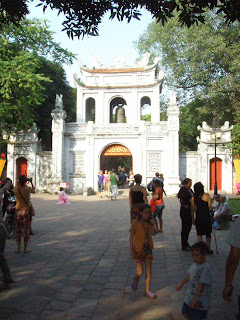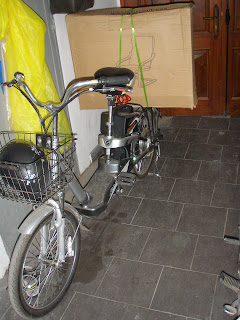I am eternally indebted to Alexandre de Rhodes, a French Jesuit scholar, for he was responsible for introducing the script which is used in Vietnam today – one that looks a lot like English. This at least gives me a fighting chance. There are several differences of course – e.g. there are 12 vowels and 17 consonants.
‘a’ has two other variants – ă and â – required because of the different sounds made in Vietnamese.
The main difficulty though, is that there are 6 tones, each indicated by an accent: á à ả ã ạ a (the last tone is no accent). Of course, you can have ‘new’ letters with accents too: ắ ẵ ở ự.
So, I can say ‘ma’ with a high, rising tone (má) and it means ‘mother’. However, if I say the same word with a tone that ends abruptly (mạ), it means ‘rice seedling’ and if I say it with what I can only describe as a wobble in my voice (mã), it means ‘horse’. You can imagine how keen I am to get that right (especially if I try some Vietnamese at family gatherings).
My personal favourite word at the moment is Mỹ. Say ‘Me’ in a voice like a mouse with hiccups and you’ll be close. Congratulations – you just said ‘America’ in Vietnamese. Honest.
If you can crack the pronunciation you are well on the way to learning the language as the grammar is quite simple so I’m putting some time in on this (but it’s going to take a while …). I need this pronunciation in class as soon as possible. On Sunday mornings I have 18 teenage students and the same in the afternoon. To be frank, I’m struggling with all the names. I’ve got most of them but when you have two Châu’s and a Trieu in the class (which sound similar) it gets tricky. I’m sure I pronounce many names incorrectly but they’re very gracious and don’t point these errors out.
Some useful phrases for the next time you bump into a Vietnamese person down the high street:
Xin chào (sin chow) - hello
Tên ban là gì? (ten ban la zi) - What is your name?
*****
There is another big difference from any other country I’ve ever been to – there are no coins. The currency is the Dong and at present the exchange rate is about 32,500 Dong to the pound. You soon get used to dealing in big numbers – I changed sixty US dollars at the airport when I arrived and became an instant Dong millionaire. The smallest denomination is a 500 Dong note and it’s worth about 1.5p. 20,000 Dong is about a dollar and you can buy a Vietnamese meal (such as the one in the last blog) in a street café for about 50,000 Dong.

The picture on the notes is Ho Chi Minh – ‘Uncle Ho’ to many here. Vietnam’s most revered character (there’ll be more about him in future blogs).
*****
Back home we use streets to get from one place to another and that’s about it but here it’s where many people conduct their lives – eating, playing badminton and even having their afternoon snooze. Everywhere you go there are families cooking, people drinking tea or beer and selling all manner of things. Badminton courts are marked out on every pavement that is wide enough to accommodate one (and which isn’t covered in bikes) and you’ll find people playing there in the mornings and evenings.


Many houses open onto the street and set themselves up selling drinks, fruit or cooked food. I buy some of my fruit from the lady around the corner. In fact, it’s often hard to get past without trying to sell me something but she’s very good to me and often gives me a ‘souvenir’ as she calls it – an extra something. Last time it was a pomegranate.

I live very near the Temple of Literature – the first ever university in Hanoi dating back to 1070 and dedicated to Confucius. It honours Vietnam’s finest scholars and the stones pictured contain the names of many of them.



Confucius is featured in many statues.


It’s a fascinating place – a quiet haven from the traffic. I was lucky enough to be there during a concert using traditional instruments. OK, I felt obliged to buy their CD but it was well worth it.

****
For the first few weeks I either walked around town or caught buses, with the occasional taxi or xeom (bike taxi) when needed. Walking around town isn’t easy as most pavements are cluttered with parked bikes and people eating, drinking and conducting assorted businesses. You invariably end up walking in the road. The buses are quite good – fairly regular and air-conditioned. A few are modern but many are falling apart. However, you only pay the equivalent of 9p to go anywhere and can sit and watch everyone take their chances in the traffic. What really impressed me though, was the bus conductors, who tell people to give up their seats for the elderly!
I eventually decided that the quickest way around town is a bike so I am now the proud owner of an electric bike. OK, Evel Knievel it is not – this thing would struggle to jump 12 matchboxes – but it gets me about well enough, and in a city where there’s too much traffic to really go fast, I keep up with the flow. Now, if crossing the road here is exciting, you should try driving. They come at you from all directions and red lights are often just for show so you can reasonably expect to have a bike or car coming at you from the side and often, head on. Amazingly, there is no road rage – totally unexpected and erratic manoeuvres are all part of the game and everyone accepts that.
To be on the safe side I bought a helmet. I went for a bog-standard black one but you can buy a wide range of them in traditional Vietnamese designs ...




To be truly Vietnamese you have to balance a totally improbable load on the back so I had a go at transporting a new IKEA-type armchair home on mine. Thanks to the chap who tied it on, it worked!

*****
Bike photo of the month.
This biker looks like he’s moving house by bike ...

*****
It seems like there are a thousand things to say about Hanoi. And that’s before I start travelling around the country. I’ll write again soon but in the meantime I have far more important things on my mind like, where on earth do I buy trousers that fit me?